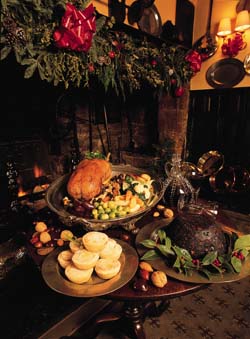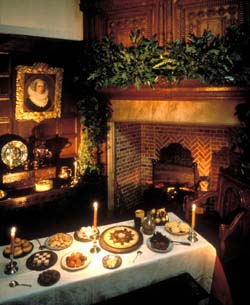An Elizabethan Christmas Feast: Sugar, Spice and All Things Nice
by Marta Patiño
 Christmas in 16th century England is best illustrated by
the old adage: 'eat, drink and be merry'. England didn't have
much cause for celebration during the dark years of Mary Tudor's
reign, which saw 300 people burnt at the stake for heresy, so the
young Elizabeth's rise to the throne was a welcome change. The
enigmatic queen swept away the stale solemnity of Mary's court,
replacing it with an appreciation for luxury, extravagance and
popular culture. Christmas in 16th century England is best illustrated by
the old adage: 'eat, drink and be merry'. England didn't have
much cause for celebration during the dark years of Mary Tudor's
reign, which saw 300 people burnt at the stake for heresy, so the
young Elizabeth's rise to the throne was a welcome change. The
enigmatic queen swept away the stale solemnity of Mary's court,
replacing it with an appreciation for luxury, extravagance and
popular culture.
The Christmas feast was the highlight of the year for those
households that could afford it and no expense was spared. A
popular main dish was Brawn and mustard, made from force-fed boar
meat. Other traditional meats served included roast beef, goose
and turkey.
Turkey was first introduced to Europe from the Americas during
Henry VIII's reign and gradually rose in popularity as a
Christmas dish, given that it was cheap and quick to fatten. For
the well-to-do, the most traditional meat eaten on Christmas Day
was goose. It is said that in 1588 Elizabeth I ordered the entire
country to serve goose at their Christmas feast, since it was the
first meal she had eaten following England's victory over the
Spanish Armada and would thus provide a fitting tribute to the
Navy Royal. Christmas was a singular occasion and each household
would have spent as much as possible on their Christmas feast.
That said, many households wouldn't have been able to comply with
the Queen's demand, since goose was at that time an expensive
luxury.
The main meat dishes were accompanied by plum porridge, minced
pies and a beer brewed specially for the occasion. During the
Elizabethan age water could carry disease and was not considered
fit to drink. Instead, beer was the staple drink for the majority
of people at all levels of society and it was common for country
homes to house their own brewery. Beer was also sold at tap
houses and taverns, which did a rollicking trade during the 12
days of Christmas.
Banqueting tables at grand homes were decked with spectacular
fare for the Christmas feast, affording the nobility an ideal
opportunity to flaunt their wealth and creativity. Roasted swans
and peacocks provided a dramatic centrepiece for affluent tables.
These elegant birds were placed at the centre of the table, their
feathers still in place despite the birds having been thoroughly
cooked. The trick was to skin them for the roasting process
before slipping them back in their skins. Wealthy households also
liked to serve wild boar, the animal's head providing yet another
spectacular table decoration.
 Along with the
discovery of the New World came a rush of unusual fruits and
vegetables. Aristocratic tables during an Elizabethan Christmas
would have been laden with exotic delicacies, such as tomatoes,
potatoes, red peppers and pineapples. Expensive foods such as
citrus fruit, quinces, melons and apricots would also have been
imported from Southern Europe for the occasion. Along with the
discovery of the New World came a rush of unusual fruits and
vegetables. Aristocratic tables during an Elizabethan Christmas
would have been laden with exotic delicacies, such as tomatoes,
potatoes, red peppers and pineapples. Expensive foods such as
citrus fruit, quinces, melons and apricots would also have been
imported from Southern Europe for the occasion.
While the lords and ladies enjoyed the choice cuts, the servants
baked the 'humbles' into a pie. Humble pie was made from deer's
kidneys, intestines, brains, heart, or liver. To make the pie the
humbles were boiled in a stew along with suet, apples and
currants and seasoned with salt, sugar and spices.
At an aristocratic Christmas meal, the piece de résistance
would have been a spectacular 'banquet course'. Featuring an
endless array of delicious and colourful sweetmeats, this course
was created more as a feast for the eyes than for the taste buds.
Sugar was the main ingredient of most of the dishes. Increased
imports of sugar from the West and East Indies, as well as just
Morocco and Barbary, ensured the English aristocracy soon
developed a sweet tooth. The Elizabethans discovered a whole host
of ways in which they could use sugar, not just in creating
desserts and confectionary, but also for seasoning vegetables and
even concocting medicinal remedies. The downside of eating so
much sugar was obviously that it made your teeth rot: it's said
that Queen Elizabeth's teeth went completely black because of her
vast appetite for sweets.
The banquet course provided yet another way for the host to
display his wealth and status, as well as his understanding of
the latest fashions. These beautiful, delicate creations were
often produced by the lady of the house, allowing her to dazzle
the guests with her culinary and artistic skills.
The showstopper was marchpane, or marzipan, made from almond
paste and sugar. It was sometimes moulded into three-dimensional
shapes and iced to resemble fruits and even slices of
baconÐcalled 'collops of bacon'. Large disc-shaped marchpanes
were at times gilded with an edible gold leaf. Other favourites
included ginger bread, quince marmalade, candied or gilded fruits
and sugar-plate. The latter was a blend of egg, sugar and
gelatine that could be moulded into any shape the chef desired.
Sugar-plate walnuts and eggs were especially popular. 'Leech' was
the name of another highly coveted sweetmeat. Made from milk,
sugar and rosewater, it was cut into cubes and often arranged to
form a chequerboard.
Although most of the sugar-laden creations were not designed to
be eaten, a selection of dessertsÐmainly tarts and custardsÐalso
typically accompanied the banqueting course.
Hot drinks were also served alongside the sweetmeats, including
mulled wine (hot wine infused with spices and sweetened with
sugar) and syllabub (spiced hot milk flavoured with rum or wine).
Another traditional festive beverage was lambswool, made by
blending hot cider, sherry or ale, spices and apples and heating
the liquid until it formed a white 'woolly' head.
The Queen typically spent Christmas in Whitehall, where the
festivities were especially extravagant. Hundreds of guests would
take part in two week-long courtly celebrations, which included
splendid feasts and unrivalled entertainment. For a fun insight
into what such an event would have been like, visitors can attend
a special 15th century-themed Christmas Banquet, held every
evening throughout December at Hatfield house, Elizabeth I's
childhood home located in the county of Hertfordshire.
To create your very own Elizabethan banquet course, here's a
selection of recipes taken from a book published in 1609 titled
Delightes for Ladies.
To make a Marchpane.
Take two pounds of Almonds being blanched and dryed in a
sieve over a fire: beat them in a stone mortar; and when they bee
small, mix with them two pounds of sugar being finely beaten,
adding 2 or 3 spoonfuls of Rose-water, and that will keeps your
almonds from oyling. When your paste is beaten fine, drive it
thin with a rowling ping, and so lay it on a bottom of wafers:
then raise up a little edge on the side, and so bake it: then yce
it with Rose-water and sugar: then put it into the oven once
again, and when you see your yce is rise up, & dry, then take
it out of the oven, & garnish it with pretty conceits, as
birds and beasts, being cast out of standing moulds. Stick long
comfits upright in it: cast biskets and carrowaies on it, and so
serve it: gild it before you serve it: you may also print off
this Marchpane paste in your molds for banquetting dishes: and of
this paste our comfitmakers at this day make their letters,
knots, Arms, Escocheons, beasts, birds, and other fancies.
To make Ginger-bread
Take three stale Manchets, and grate them: dry them, and sift
them thorow a fine sieve: then adde unto them one ounce of Ginger
being beaten, and as much Cinamon, one ounce of Liquorice and
Anniseeds beeing beaten together, and searced, halfe a pound of
sugar; then boil all these together in a posnet, with a quart of
claret wine, till they come to a stiff paste with often stirring
of it; and when it is stiffe, mould it on a table, and so drive
it thin, and put it in your moulds: dust your moulds with
Cinamon, Ginger, and Liquorice, being mixed together in fine
powder. This is your Ginger-bread used at the Court, and in all
Gentlemens houses at festival times. It is otherwise called dry
Leach.
To make Leach of Almonds.
Take halfe a pound of sweet Almonds, and beat them in a
mortar; then strain them with a pint of sweet milke from the cow;
then put to it one graine of musk, 2 spoonfuls of Rose-water, two
ounces of fine sugar, the weight of 3 whole shillings of
Isinglass that is very white, and so boyle them; and let all run
thorow a strainer: then may you slice the same, and so serve
it.
More Information:
We regret that we no longer have the resources to maintain up-to-date links and/or hours and pricing details for the various sites and attractions listed on this website. For more information about the location(s) listed above, please use your favorite search engine or visit Wikipedia.
A freelance writer based in the Canary Islands, Marta
Patiño is the former editor of Living Tenerife.
She now contributes articles to a number of publications on
travel and history.
Article © 2005 Marta Patiño
Top photo courtesy of BritainOnView.com; lower photo courtesy of the Geffrye Museum.
|
